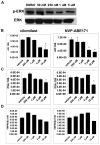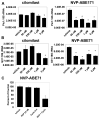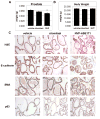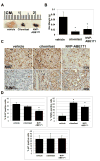Phosphodiesterase 4D inhibitors limit prostate cancer growth potential
- PMID: 25149359
- PMCID: PMC4312503
- DOI: 10.1158/1541-7786.MCR-14-0110
Phosphodiesterase 4D inhibitors limit prostate cancer growth potential
Abstract
Phosphodiesterase 4D (PDE4D) has recently been implicated as a proliferation-promoting factor in prostate cancer and is overexpressed in human prostate carcinoma. However, the effects of PDE4D inhibition using pharmacologic inhibitors have not been examined in prostate cancer. These studies examined the effects of selective PDE4D inhibitors, NVP-ABE171 and cilomilast, as anti-prostate cancer therapies in both in vitro and in vivo models. The effects of PDE4D inhibitors on pathways that are critical in prostate cancer and/or downstream of cyclic AMP (cAMP) were examined. Both NVP-ABE171 and cilomilast decreased cell growth. In vitro, PDE4D inhibitors lead to decreased signaling of the sonic hedgehog (SHH), androgen receptor (AR), and MAPK pathways, but growth inhibition was best correlated to the SHH pathway. PDE4D inhibition also reduced proliferation of epithelial cells induced by paracrine signaling from cocultured stromal cells that had activated hedgehog signaling. In addition, PDE4D inhibitors decreased the weight of the prostate in wild-type mice. Prostate cancer xenografts grown in nude mice that were treated with cilomilast or NVP-ABE171 had decreased wet weight and increased apoptosis compared with vehicle-treated controls. These studies suggest the pharmacologic inhibition of PDE4D using small-molecule inhibitors is an effective option for prostate cancer therapy.
Implications: PDE4D inhibitors decrease the growth of prostate cancer cells in vivo and in vitro, and PDE4D inhibition has therapeutic potential in prostate cancer.
©2014 American Association for Cancer Research.
Conflict of interest statement
Conflict of Interest: The authors declare no conflict of interest.
Figures






References
Publication types
MeSH terms
Substances
Grants and funding
LinkOut - more resources
Full Text Sources
Other Literature Sources
Medical
Research Materials

